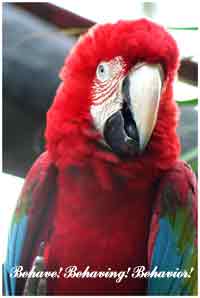Behave! Behaving! Behavior!
by W. Brian Greger
So what is it about parrots’ behaviors? We all have been enthralled, entertained, and sometimes disturbed with our feathered friends’ behaviors. I love watching Dewey, our GW macaw, fly and do mid-air acrobatics. He seems to have so much fun learning another twist, dive, and stall routine. I am comforted seeing my macaws ruffle up their feathers after a nice scritching. At the same time, I am deeply torn when I see them fearful or aggressive. It is all these human emotions that I go through on a day-to-day basis with my companion macaws.
I realize that not only do I need to take care of their physical needs, but just as importantly I have to take care of their psychological welfare. I can manage their physical needs fairly easily, but the psychological stuff; well that is another story. Here I have to work at it to really help my macaws learn behaviors that empower them to be mentally healthy and content in my home.
At first glance, behaviors may seem simple, but the more I learn I realize behaviors are very complex. Here is where Applied Behavior Analysis, "ABA", opened up a wonderful new world for me and our macaws.
So what is ABA? ABA is the application of the principles of behavior to teach or modify behaviors. By understanding and using these principles of behavior, we can assess current behaviors, and then we can design, implement, and evaluate environmental modifications to produce significant improvements in behavior.
One of the principle rules of behavior is that the environment shapes behavior. And for most behaviors, the immediate environmental consequence after the behavior will determine whether or not the behavior will increase or decrease in the future. This principle is so important to remember: Immediate consequences increase or decrease the frequency of future behaviors.
For example: We want our parrots to cooperate with us to step-up off the cage. If we provide a reward immediately and consistently after each step-up, our birds will increasingly step up off the cage. Whereas, if we put our birds back in their cage immediately and consistently after each step-up off the cage, our birds will most likely decreasingly step up off the cage.
By understanding and observing this one important rule, you can start to gain insight why your bird behaves. Next time you wonder why your bird does what they do, take a closer look and identify the immediate consequence. Now you are on your way to making a difference.
For our captive parrot companions, we strive to empower them to make choices while at the same time have them cooperate with us. By using ABA and by providing ethical and positively reinforcing environments, we can improve the psychological quality of life for our birds, and we can also build cooperative and trusting relationships. My relationship with my macaws is deeper and more cooperative than I could have ever imagined. And most importantly, my macaws’ psychological welfares have benefited tremendously. This is my greatest gift to my feathered friends.

